|
“Standard de Liège” at First Place and Kawashima’s Role (No.45)
3 March 2014
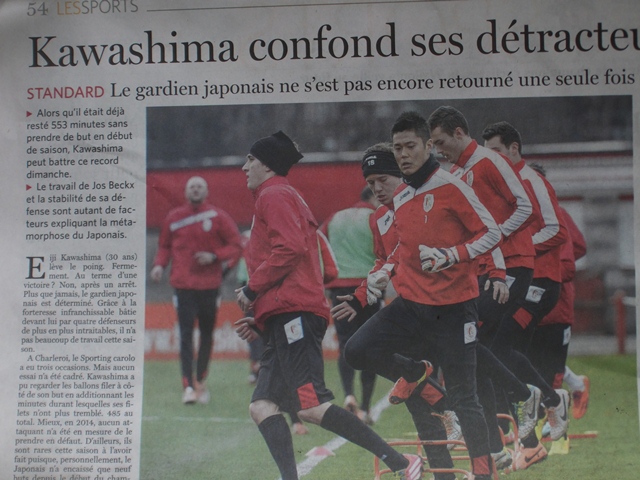 About one week ago, I was invited by a Belgian friend to watch the Premier League football match between Liège and Ghent. Liège is located 90 km east of Brussels and it takes about one hour by car. Mr Eiji Kawashima, the regular goal keeper of Japan’s national team, belongs to the prestigious team called “Standard de Liège” (founded in 1898) which is based in this town and he plays an active part in almost all matches. Mr Yuji Ono and Kensuke Nagai also joined the team last year, but Mr Ono, who is aiming at his return in the field after being injured, has not had a chance to play yet and Mr Nagai has been rented out to Nagoya Grampus. “Standard de Liège” is doing very well this season and is on top by 19 wins, 3 losses and 6 draws out of 28 matches. If they keep it up, it is possible they will become champion for the first time in five seasons. The last four years of Standard de Liège were very bad, the coach changed almost every year and last season Mr Kawashima got strongly criticised. About one week ago, I was invited by a Belgian friend to watch the Premier League football match between Liège and Ghent. Liège is located 90 km east of Brussels and it takes about one hour by car. Mr Eiji Kawashima, the regular goal keeper of Japan’s national team, belongs to the prestigious team called “Standard de Liège” (founded in 1898) which is based in this town and he plays an active part in almost all matches. Mr Yuji Ono and Kensuke Nagai also joined the team last year, but Mr Ono, who is aiming at his return in the field after being injured, has not had a chance to play yet and Mr Nagai has been rented out to Nagoya Grampus. “Standard de Liège” is doing very well this season and is on top by 19 wins, 3 losses and 6 draws out of 28 matches. If they keep it up, it is possible they will become champion for the first time in five seasons. The last four years of Standard de Liège were very bad, the coach changed almost every year and last season Mr Kawashima got strongly criticised.
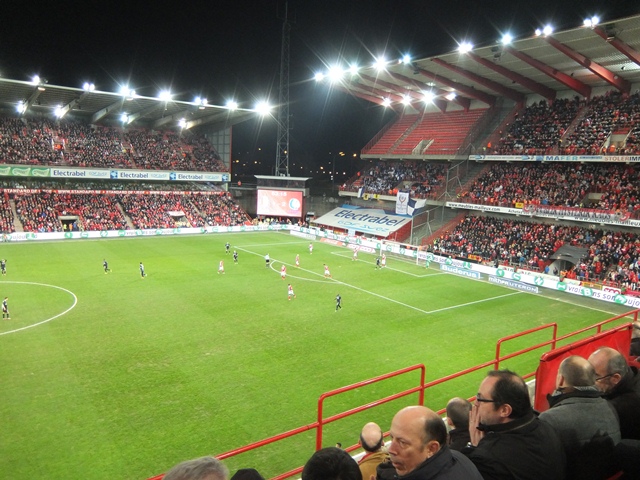 However, with the start of this year’s season he became quite literally a “guardian god”, contributing greatly to the consecutive wins of the team. The Belgian media also changed its attitude quickly and praised him to the skies. The opponent in the game I watched one week ago, KAA Ghent, currently holds 7th place out of 16 in the Premier League and having still a chance to go through to the play-offs (in which the upper six teams participate), the match was a frantic battle. “Standard” lost with 2-3. Furthermore, yesterday Standard lost as well the decisive match against “Brugge”, that holds the second place in the league. It was the first consecutive defeat for Standard this season. Although Mr Kawashima only missed 12 balls in 25 matches, three of those happened to be in these two matches. However, they had 16 no-goal games and I hope they will keep up somehow their good condition until the World Cup next June. However, with the start of this year’s season he became quite literally a “guardian god”, contributing greatly to the consecutive wins of the team. The Belgian media also changed its attitude quickly and praised him to the skies. The opponent in the game I watched one week ago, KAA Ghent, currently holds 7th place out of 16 in the Premier League and having still a chance to go through to the play-offs (in which the upper six teams participate), the match was a frantic battle. “Standard” lost with 2-3. Furthermore, yesterday Standard lost as well the decisive match against “Brugge”, that holds the second place in the league. It was the first consecutive defeat for Standard this season. Although Mr Kawashima only missed 12 balls in 25 matches, three of those happened to be in these two matches. However, they had 16 no-goal games and I hope they will keep up somehow their good condition until the World Cup next June.
< Japanese Festival at UCL >
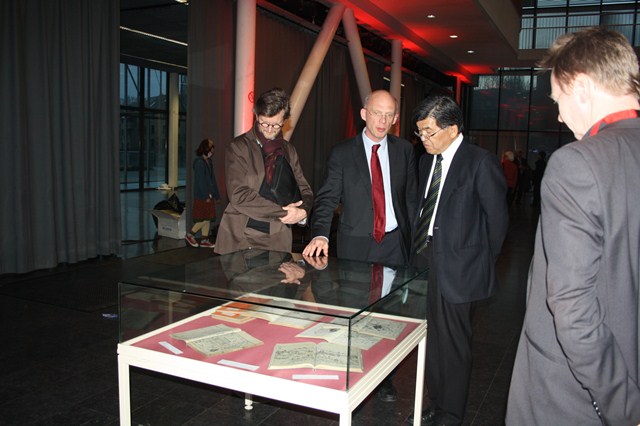 Last week, a Japanese festival was held at UCL (Université catholique de Louvain) and I attended the evening event. This Japanese festival was organized by UCL, but a Japanese volunteer NGO, called “MIRAI ASBL” played a central part in the preparation. This NGO invited junior and high school students from the Tohoku area to Belgium after the Great East Japan earthquake and I was told that the proceeds of the Japanese festival would be used for the funding of this invitation project. There was an exhibition corner where about one hundred pictures of the Tohoku landscape after the earthquake, taken by a Belgian photographer, were shown and where books of the late Edo period, owned by the university (a donation from Emperor Hirohito on his official visit to Belgium after WWI when he was still Crown Prince) were on display. Last week, a Japanese festival was held at UCL (Université catholique de Louvain) and I attended the evening event. This Japanese festival was organized by UCL, but a Japanese volunteer NGO, called “MIRAI ASBL” played a central part in the preparation. This NGO invited junior and high school students from the Tohoku area to Belgium after the Great East Japan earthquake and I was told that the proceeds of the Japanese festival would be used for the funding of this invitation project. There was an exhibition corner where about one hundred pictures of the Tohoku landscape after the earthquake, taken by a Belgian photographer, were shown and where books of the late Edo period, owned by the university (a donation from Emperor Hirohito on his official visit to Belgium after WWI when he was still Crown Prince) were on display. 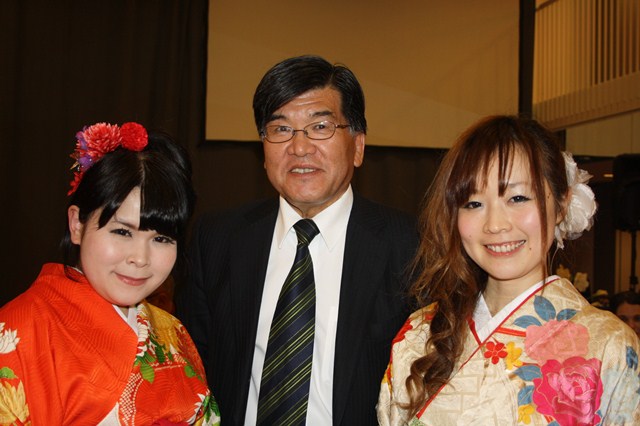 In addition to these exhibitions, Japanese food-tasting, an origami and calligraphy demonstration and a koto performance were held at the Aula Magna event hall of the university. It was a big success attracting more than one thousand people, mostly students. I got to listen to a live performance of ‘tsugaru shamisen’ (a three-stringed musical instrument from the northern part of Japan) by two young Japanese women at dinner and I felt nostalgic listening to the sound of the shamisen in a foreign country. The fun was a bit spoiled though when a person from the university seated next to me commented that it was like a banjo… Before going back home, a Belgian woman who teaches French at Fukuoka University in Japan gave me a heavy book called “The Intimate Diary of Benjamin Constant”, which her husband Mr Fuyutake Takatou (Professor Emeritus of Kyushu University) translated. Benjamin Constant was a unique person who was a politician living in the turbulent times after the French revolution and a writer of romance novels. This unexpected gift in an unexpected place made me very happy. In addition to these exhibitions, Japanese food-tasting, an origami and calligraphy demonstration and a koto performance were held at the Aula Magna event hall of the university. It was a big success attracting more than one thousand people, mostly students. I got to listen to a live performance of ‘tsugaru shamisen’ (a three-stringed musical instrument from the northern part of Japan) by two young Japanese women at dinner and I felt nostalgic listening to the sound of the shamisen in a foreign country. The fun was a bit spoiled though when a person from the university seated next to me commented that it was like a banjo… Before going back home, a Belgian woman who teaches French at Fukuoka University in Japan gave me a heavy book called “The Intimate Diary of Benjamin Constant”, which her husband Mr Fuyutake Takatou (Professor Emeritus of Kyushu University) translated. Benjamin Constant was a unique person who was a politician living in the turbulent times after the French revolution and a writer of romance novels. This unexpected gift in an unexpected place made me very happy.
< The Repairmen of Aeroplane Tyres >
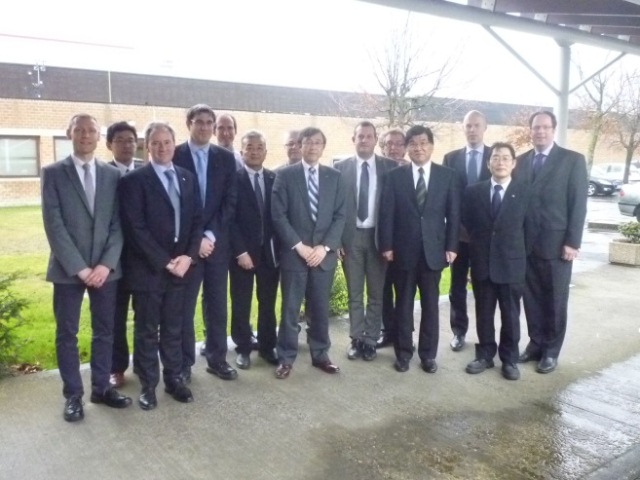 When travelling by plane we experience the thumping of the tyres when making contact with the ground upon landing on the runway. Of course you understand the intensity of the impact and wear and tear on the tyres when looking at footage of the white smoke coming from the tyres. Now, how many landings do those tyres endure and how often do they need to be replaced? Last week I went on a study trip to the Bridgestone factory (179 employees) in Frameries (21.000 inhabitants) in the Hainaut Province, 70 km south of Brussels, and got an answer to these questions. The answer: 300 landings and roughly every four months the tyres need to be replaced. When travelling by plane we experience the thumping of the tyres when making contact with the ground upon landing on the runway. Of course you understand the intensity of the impact and wear and tear on the tyres when looking at footage of the white smoke coming from the tyres. Now, how many landings do those tyres endure and how often do they need to be replaced? Last week I went on a study trip to the Bridgestone factory (179 employees) in Frameries (21.000 inhabitants) in the Hainaut Province, 70 km south of Brussels, and got an answer to these questions. The answer: 300 landings and roughly every four months the tyres need to be replaced.
The official name of this factory is ‘Bridgestone Aircraft Tire Europe’ (BAE), which was acquired by Bridgestone Corporation from the American company Thompson (founded in 1967) in 1991. They provide a specialised ‘tyre rethreading’ service to its clients (aircraft companies), who bring in their heavily worn tyres. The tyre surface is peeled off, re-covered into a new tyre and returned to the client. Per year about 100.000 tyres in various sizes are brought in, but nearly 30% of the tyres are declared unsuitable for re-use at prior inspection; only the remaining 70% are rethreaded at the Frameries site. In other words, if converted to a figure of a one-day production day at the factory, the daily average of retreaded tyres would be 288 and the huge factory is filled with tyres. BAE is Bridgestone’s only tire rethreading factory in Europe and I was surprised to learn that it holds a market share of 49% (40% of the global share). Michelin and Goodyear are main competitors, but the following promising answer came from Mr Suzuki, the head of the factory saying: “The bigger the tyres, the stronger Bridgestone.”
< Belgium’s Martial Arts’ Masters >
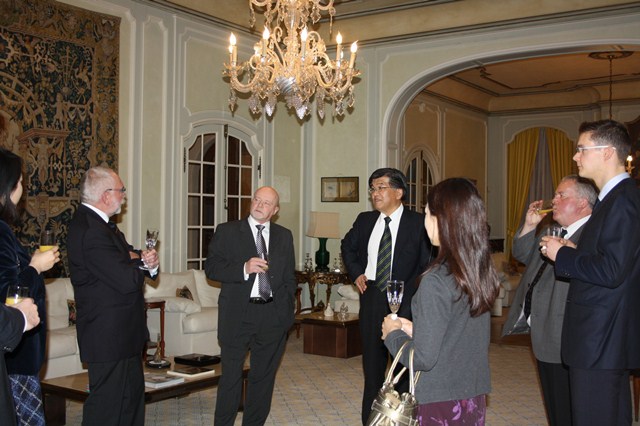 Last week at the Ambassador’s residence, I had the chance to informally chat with Belgian members of the judo, kendo and aikido associations. These kind of Japanese martial arts are popular in Belgium and produce many members that are active in international championships. Besides those, there also is a Naginata and Karate Federation which both have close ties with clubs in Japan. According to the president of the judo federation Mr Michel Bertrand, there are as many as 30.000 judo-practitioners in Belgium. Considering that the national population is one eleventh of Japan’s, it is quite a lot. Aikido has a little less than 5000 members, but is nonetheless appointed as an organization eligible to receive subsidies from the regional government. The Kendo Federation having only five to six hundred members does not receive any subsidy and relies on the yearly membership fee of 280 euro to operate. Last week at the Ambassador’s residence, I had the chance to informally chat with Belgian members of the judo, kendo and aikido associations. These kind of Japanese martial arts are popular in Belgium and produce many members that are active in international championships. Besides those, there also is a Naginata and Karate Federation which both have close ties with clubs in Japan. According to the president of the judo federation Mr Michel Bertrand, there are as many as 30.000 judo-practitioners in Belgium. Considering that the national population is one eleventh of Japan’s, it is quite a lot. Aikido has a little less than 5000 members, but is nonetheless appointed as an organization eligible to receive subsidies from the regional government. The Kendo Federation having only five to six hundred members does not receive any subsidy and relies on the yearly membership fee of 280 euro to operate. 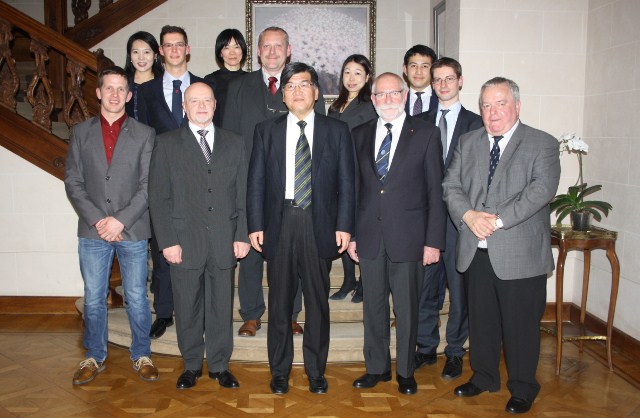 The president of the Walloon Aikido Federation, Mr Frédéric Heylbroeck, is a 32-year old young lawyer, but he shows also administrative skills as an official at international championships. Belgian judo champion Mr Dirk Van Tichelt competes in the 72 kg class and last year became fifth after beating the Japanese champion. He also told me that in the near future he is planning on visiting Japan to train at Tenri and Tokai University. When I asked about Charline van Snick, the bronze medallist in the women 48 kg division at the previous London Olympics, I was suddenly met with gloomy faces. She has been sanctioned with a suspension from international judo tournaments for two years, on suspicion of doping usage last fall. I was told it was a sad situation for the family involved as well. There are also a lot of injuries in martial arts, which makes it seem a difficult world. The president of the Walloon Aikido Federation, Mr Frédéric Heylbroeck, is a 32-year old young lawyer, but he shows also administrative skills as an official at international championships. Belgian judo champion Mr Dirk Van Tichelt competes in the 72 kg class and last year became fifth after beating the Japanese champion. He also told me that in the near future he is planning on visiting Japan to train at Tenri and Tokai University. When I asked about Charline van Snick, the bronze medallist in the women 48 kg division at the previous London Olympics, I was suddenly met with gloomy faces. She has been sanctioned with a suspension from international judo tournaments for two years, on suspicion of doping usage last fall. I was told it was a sad situation for the family involved as well. There are also a lot of injuries in martial arts, which makes it seem a difficult world.
< Dinant, Adolphe Sax, and the Senzoku Gakuen College of Music >
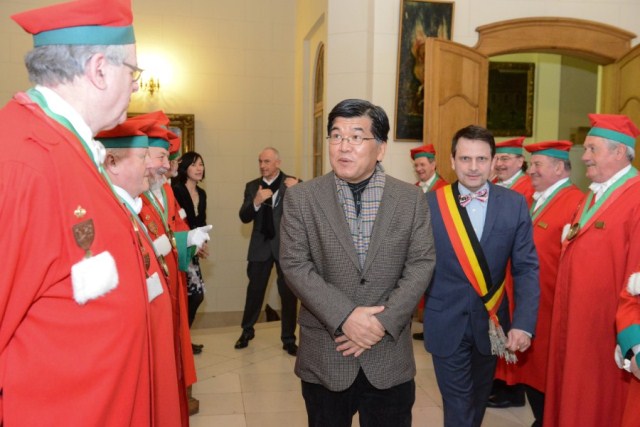 I do not think there is anyone that does not know the wind instrument the saxophone, but I believe most Japanese do not know who invented it and when. In fact, this instrument was invented over 150 years ago by a Belgian called Adolphe Sax (1814-1894). In his birthplace Dinant (93km to the southeast of Brussels; Population: 13.000) many events are held to commemorate the 200th anniversary of his birth this year. For one of these events more than 50 students of the Japanese Senzoku Gakuen College of Music (wind instrument students) were invited to Dinant. I also attended the welcome party that was organized by Mayor Richard Fournaux and greeted them. I do not think there is anyone that does not know the wind instrument the saxophone, but I believe most Japanese do not know who invented it and when. In fact, this instrument was invented over 150 years ago by a Belgian called Adolphe Sax (1814-1894). In his birthplace Dinant (93km to the southeast of Brussels; Population: 13.000) many events are held to commemorate the 200th anniversary of his birth this year. For one of these events more than 50 students of the Japanese Senzoku Gakuen College of Music (wind instrument students) were invited to Dinant. I also attended the welcome party that was organized by Mayor Richard Fournaux and greeted them. 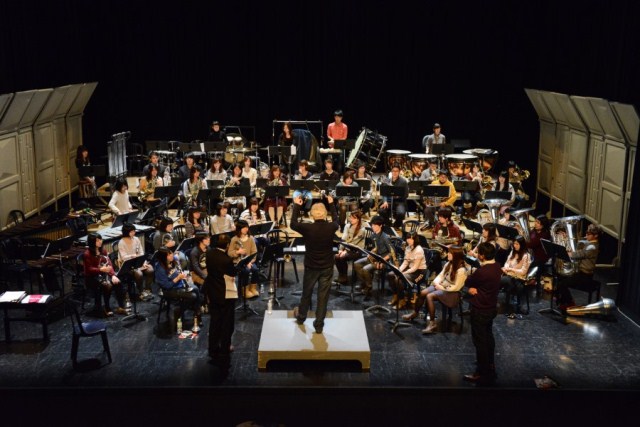 In Dinant, once every four years, an International Saxophone Competition is held. Already 226 people, of whom apparently 56 are Japanese, have applied for the 6th Competition, which is scheduled for the autumn of this year. A Japanese won the competition of 2002. Dinant is a picturesque town situated on the banks of the Meuse-river. On the top of a more than 100-metre cliff a mid-11th century Citadel (the current structure was rebuilt in the early 19th century) was built and it is one of the most beautiful sceneries in Belgium. I have been invited by Mayor Fournaux to the event on the 13th of December, Adolphe Sax’s birthday, so I am already looking forward to that revisit. In Dinant, once every four years, an International Saxophone Competition is held. Already 226 people, of whom apparently 56 are Japanese, have applied for the 6th Competition, which is scheduled for the autumn of this year. A Japanese won the competition of 2002. Dinant is a picturesque town situated on the banks of the Meuse-river. On the top of a more than 100-metre cliff a mid-11th century Citadel (the current structure was rebuilt in the early 19th century) was built and it is one of the most beautiful sceneries in Belgium. I have been invited by Mayor Fournaux to the event on the 13th of December, Adolphe Sax’s birthday, so I am already looking forward to that revisit.
|

